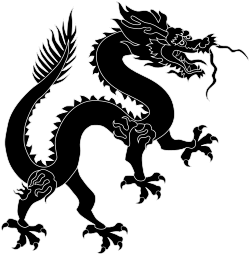Unsolved:Dragon (zodiac)
| Dragon |
|---|

The Dragon, also known as Loong, (simplified Chinese: 龙; traditional Chinese: 龍; pinyin: lóng; Jyutping: lung4; Cantonese Yale: lùhng) is the fifth of the 12-year cycle of animals which appear in the Chinese zodiac related to the Chinese calendar. The Year of the Dragon is associated with the Earthly Branch symbol 辰, pronounced chen.
It has been proposed by one academic researcher that the Earthly Branch character may have been associated with scorpions; it may have symbolized the star Antares.[1] In the Buddhist calendar used in Thailand, Cambodia, Laos, Myanmar, and Sri Lanka, the Dragon is replaced by the nāga.[2] In the Gurung zodiac, the Dragon is replaced by the eagle.[3] In Old Turkic calendar it is replaced by the fish or crocodile. Early Persian translations of the medieval period change the dragon to a sea serpent although in current times it is generally referred to as whale.[4][5]
During the Cultural Revolution, there was an attempt to replace the symbol with the Giant Panda; however, the movement was short lived.[6][7]
Years and the Five Elements
People born within these date ranges can be said to have been born in the "Year of the Dragon", while bearing the following elemental sign:
| Start date | End date | Heavenly branch |
|---|---|---|
| 23 January 1928 | 9 February 1929 | Earth Dragon |
| 8 February 1940 | 26 January 1941 | Metal Dragon |
| 27 January 1952 | 13 February 1953 | Water Dragon |
| 13 February 1964 | 1 February 1965 | Wood Dragon |
| 31 January 1976 | 17 February 1977 | Fire Dragon |
| 17 February 1988 | 5 February 1989 | Earth Dragon |
| 5 February 2000 | 23 January 2001 | Metal Dragon |
| 23 January 2012 | 9 February 2013 | Water Dragon |
| 10 February 2024 | 28 January 2025 | Wood Dragon |
| 28 January 2036 | 14 February 2037 | Fire Dragon |
| 14 February 2048 | 1 February 2049 | Earth Dragon |
| 2 February 2060 | 20 January 2061 | Metal Dragon |
| 19 February 2072 | 6 February 2073 | Water Dragon |
| 6 February 2084 | 25 January 2085 | Wood Dragon |
| 25 January 2096 | 11 February 2097 | Fire Dragon |
There are typically marked spikes in the birth rates of countries that use the Chinese zodiac or places with substantial Overseas Chinese populations during the year of the Dragon, because such "Dragon babies" are considered to be lucky and have desirable characteristics that supposedly lead to better life outcomes.[8][9] The relatively recent phenomenon of planning a child's birth in the Dragon year has led to hospital undercapacity issues and even an uptick in infant mortality rates toward the end of these years due to strained neonatal resources.
Compatibility
| Sign | Best Match/ Balance (1st Trine Group) | Match | No Match/ Rival-Enemy-Obstacle (Opposite Sign) |
| Dragon | Monkey, Rat | Rooster, Snake, Pig, Horse | Dog, Ox, Goat |
Cycle: (Trine Group) Dragon needs Monkey, Monkey needs Rat, Rat needs Dragon, (Opposite Sign) his rivalry needs to oppose the Dog.
Basic astrology elements
| Earthly Branches: | Chen |
| The Five Elements: | Earth |
| Yin Yang: | Yang |
| Lunar Month: | Third |
| Lucky Numbers: | 3, 6, 7; Avoid: 2, 8, 9 |
| Lucky Flowers: | hyacinths |
| Lucky Colors: | yellow, green; Avoid: blue, red |
| Season: | Spring |
References
- ↑ Richard S. Cook (Spring 1997). "The Etymology of Chinese Chen". Linguistics of the Tibeto-Burman Area (University of California, Berkeley) 18 (2): 250. ISSN 0731-3500. OCLC 4790670. http://linguistics.berkeley.edu/~rscook/socrates/public_html/html/LTBA-18.2.html.
- ↑ "Year of the Dragon – Naga – Thai Zodiac". Thai Guide to Thailand. http://www.thaiguidetothailand.com/magic-and-superstition/year-of-the-dragon-naga-thai-zodiac/.
- ↑ "Tamu (Gurung) Losar Festival". ECS Nepal. 2010-07-11. http://ecs.com.np/culture/tamu-gurung-losar-festival.
- ↑ Rasulid Hexaglot. P. B. Golden, ed., The King's Dictionary: The Rasūlid Hexaglot – Fourteenth Century Vocabularies in Arabic, Persian, Turkic, Greek, Armenian and Mongol, tr. T. Halasi- Kun, P. B. Golden, L. Ligeti, and E. Schütz, HO VIII/4, Leiden, 2000.
- ↑ Jan Gyllenbok, Encyclopaedia of Historical Metrology, Weights, and Measures, Volume 1, 2018, p. 244.
- ↑ Doug Bandow, 2021, Presenting the Chinese Dragon as a Giant Panda, Cato Institute
- ↑ Parramatta History and Heritage, Lunar New Year - Year of the Dragon
- ↑ Goodkind, Daniel (1991). "Creating new traditions in modern Chinese populations: Aiming for birth in the Year of the Dragon.". Population and Development Review 17 (4): 663–686. doi:10.2307/1973601.
- ↑ Goodkind, Daniel (1996). "Chinese lunar birth timing in Singapore: New concerns for child quality amidst multicultural modernity.". Journal of Marriage and the Family 58 (3): 784–795. doi:10.2307/353736.
External links
 |

